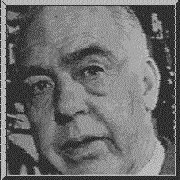 Niels
Henrik David Bohr,
was born in Copenhagen, Holland on October 7, 1885.
He was the son of a university professor. He earned his Ph.D. degree
from the University of Copenhagen in 1911. That year he went to
England and began to study nuclear physics with Joseph Thomson and
Ernest Rutherford.
Niels
Henrik David Bohr,
was born in Copenhagen, Holland on October 7, 1885.
He was the son of a university professor. He earned his Ph.D. degree
from the University of Copenhagen in 1911. That year he went to
England and began to study nuclear physics with Joseph Thomson and
Ernest Rutherford.
Niels Bohr was awarded a Nobel Prize for physics in 1922 for his work on determining the structure of the atom. Bohr's work combined the quantum theory with the Planck constant (the ratio between quantum size and the frequency of radiation from the atom). He suggested that atoms emit electromagnetic radiation when electrons move from one energy level to another.
In 1916 Bohr returned to Holland and accepted a position as a professor of physics at the University of Copenhagen. Later in his career he began the study of fission. He demonstrated that uranium 235 is an isotope that splits to form other atoms. He moved to the United States of America during World War II and worked on the development of the first atomic bomb. After World War II he returned to Holland and began work on peaceful uses of atomic energy. Bohr organized the first Atoms for Peace Conference in 1955. In 1957 he received the Atoms of Peace Award. Niels Bohr died in Holland on November 18, 1962.
References
Asimov, I. (1964). Asimov's Biographical Encyclopedia of Science and Technology: The Living Stories of More than 1000 Great Scientists from the Age of Greece to the Space Age Chronologically Arranged. Garden City, NY: Doubleday.
Daintith, J., Mitchell, S., & Tootill, E. (1981). A Biographical Encyclopedia of Scientists. New York: Facts on File.
Howard, A.V. (1951). Chamber's Dictionary of Scientists. London: Chambers.
McGraw-Hill (1966). McGraw-Hill Modern Men of Science. New York: McGraw Hill.